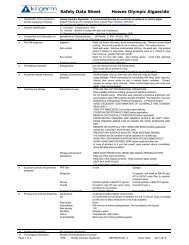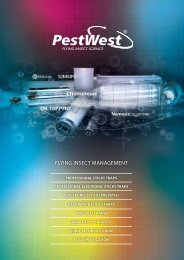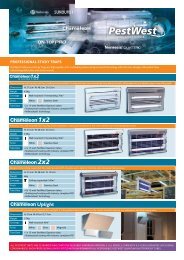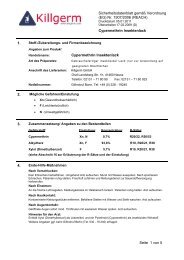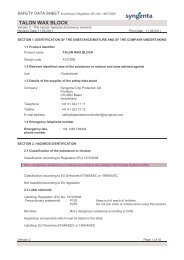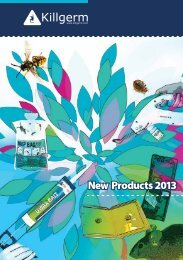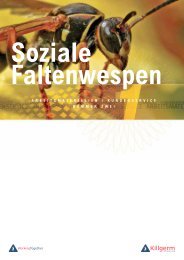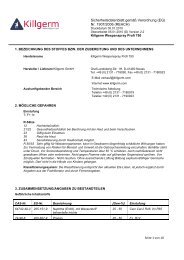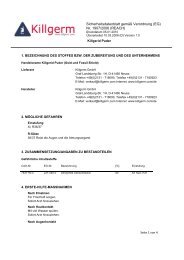Download - Killgerm Chemicals Ltd
Download - Killgerm Chemicals Ltd
Download - Killgerm Chemicals Ltd
You also want an ePaper? Increase the reach of your titles
YUMPU automatically turns print PDFs into web optimized ePapers that Google loves.
BedBug CONTROL<br />
PRACTICAL TIPS
2<br />
The situation regarding bedbugs in the UK has been well reported in recent years. In short, they are a problem! In response<br />
to the reported problems, a number of useful technical references regarding bedbug biology and control have been produced.<br />
This brief guide aims to provide useful practical tips for bedbug control, complementing existing publications such as the<br />
Greater London Pest Liaison Group Good Practice Guides, the <strong>Killgerm</strong> Bedbug Manual and advisory documents from<br />
overseas, like the ‘Code of Practice for the Control of Bed Bug Infestations in Australia’.<br />
What follows is not a step-by-step guide to control, but a collection of ‘pointers’ that may help experienced technicians and<br />
new-starters alike.<br />
Identification<br />
When bedbug activity has been confirmed, it is important to identify the bedbug species. Remember that as well as the<br />
common bedbug Cimex lectularius, other species can be found in the UK, such as the pigeon bug Cimex columbarius,<br />
bat bugs Cimex pipistrelli and the martin bug Oeciacus hirundinis. Knowing which species you are dealing with will help<br />
pinpoint the source(s) of the bug activity. It is worth noting that the tropical bedbug, Cimex hemipterus, is found in many<br />
parts of the world and occasionally turns up in the UK.<br />
Identification tips:<br />
• Carry screw-top sample jars and a x10 hand lens for insect identification in the field<br />
• Consult an identification reference for guidance<br />
• If you are photographing a pest for ID, take a picture of the dorsal and ventral surfaces (top and bottom) and from the<br />
side and another of the specimen next to a scale<br />
• Seek identification from an entomologist if you are unsure which insect species you are dealing with<br />
• Digital microscopes are available should you wish to take detailed photographs of a specimen to aid identification<br />
Products available:<br />
Magnifying glass, digital microscope.<br />
Magnifying glass<br />
sTEREO MiCROsCOPE XE5-70C-2l<br />
digiTal MiCROsCOPE digiTal MiCROsCOPE sTand
Inspection<br />
A thorough visual inspection should be conducted and the guidance documents listed in the introduction of this booklet<br />
give excellent advice on how to carry out such inspections.<br />
useful practical tips include:<br />
• Use a torch to illuminate dark cracks & crevices<br />
• Carry a hand lens to aid close-up inspection<br />
• A flushing agent (generally a pyrethroid insecticidal spray) is an essential part of a thorough inspection, as visual<br />
inspection with a torch and/or hand lens will generally not reveal all the bedbugs present<br />
• Consider the use of a bedbug detection kit*<br />
* Bedbug detection kits are a new tool available to aid inspections. The kits contain a speciality torch used in forensic investigations. Proteins<br />
from bedbug blood-spotting, exuviae (cast cuticle) and eggs fluoresce in the torch light, when viewed through orange filter goggles.<br />
Products available:<br />
Torches, flushing agent (e.g. Bayer Flying Insect Killer), bedbug detection kit.<br />
MagliTE TORCh BayER flying insECT KillER BEdBug dETECTiOn KiT<br />
3
4<br />
Monitoring & Prevention<br />
Monitoring and prevention methods are an essential part of any Integrated Pest Management (IPM) programme and<br />
bedbug control is no exception.<br />
Monitors, barriers and mattress encasements can all prove useful. It should be recognised that these tools are not control<br />
measures. They are suitable as; ‘early-warning’ systems, preventative measures before bedbugs are introduced, part<br />
of post-treatment procedures, including determining the success of treatments and identifying areas that require further<br />
attention.<br />
Research from the University of Florida Urban Entomology department has shown that female bedbugs disperse from<br />
the established harbourages to avoid multiple traumatic inseminations and male bugs will also disperse to avoid mating<br />
competition with other males (Pfiester et al., 2008). This dispersal behaviour should be taken into account when monitoring<br />
for bedbugs and it is advisable to use a number of bedbug monitors placed strategically throughout a room - do not just<br />
place the monitors near the bed.<br />
There are many different bedbug monitors available and some practical tips on their use are:<br />
• Use passive traps that are ‘harbourage mimics’ - these allow continuous monitoring for bedbug activity<br />
• Select bedbug monitors that are discreet for use in bedrooms<br />
• Monitors with a white outer case are particularly appropriate, as ‘blood spots’, frequently produced by bedbugs, can easily<br />
be identified on the white surface<br />
• If inexpensive bedbug monitors are used, it is possible to deploy a reasonable number in a room, without concerns over cost<br />
• Give careful consideration when placing the monitors to maximise their efficacy. Place them behind bed headboards, on<br />
the sides of mattresses, underneath beds, behind bedside cabinets etc.<br />
• Use ‘active’ bedbug monitors based on heat attractants to give a snapshot of bedbug activity over a number of days<br />
Products available:<br />
<strong>Killgerm</strong> bedbug monitor, BB Alert - Active Bedbug Monitor, Bug Dome, bedbug detector.<br />
KillgERM BEdBug MOniTOR<br />
BEdBug dETECTOR<br />
BB alERT - aCTivE BEdBug MOniTOR Bug dOME
Mattress encasements are a key component of an overall bedbug management programme. Their use is supported by<br />
scientific evidence and expert recommendations, as described in the article ‘Bedbugs and Mattress Encasements’, in Issue<br />
86 of Pest Control News.<br />
• Use mattress encasements to prevent bedbugs from accessing the mattress<br />
• Quality encasements will contain any bugs that remain on the mattress<br />
• The seamless surface of mattress encasements provides fewer available harbourage sites for bedbugs than an<br />
unprotected mattress<br />
• Select a ‘bite proof’ encasement so any bedbugs trapped underneath are unable to bite through the covering<br />
• Choose an encasement with a ‘bug proof’ zip, which prevents bedbug escape and penetration<br />
• Make sure the mattress encasement has been tested extensively, by an independent research laboratory using scientific<br />
methodology<br />
• Use mattress encasements to avoid the need to dispose of mattresses that are harbouring bedbugs<br />
• Protect the mattress post-insecticide treatment, in order to give long-term protection whilst minimising insecticide use<br />
after initial application<br />
Barrier devices are now available that are designed to prevent bedbugs climbing beyond the bed legs.<br />
• Use bedbug barrier devices such as the Bed Bug Moat ® . The Bed Bug Moat ® will capture, inside the moat, any bug that<br />
comes from the floor area.<br />
• Place the barriers correctly - underneath the furniture legs, ensuring no part of the bed (or bed linen) touches the wall<br />
or floor<br />
Two final recommendations regarding monitoring devices are - they should be checked frequently with monitoring data<br />
recorded regularly and crucially, monitors never replace the hard work and keen eye of the technician!<br />
Products available:<br />
Protect-A-Bed ® mattress covers, polythene mattress disposal bags, Bed Bug Moat ® .<br />
PROTECT-a-BEd ® MaTTREss COvERs<br />
BEd Bug MOaT ®<br />
5
6<br />
Insecticides & resistance<br />
management<br />
Various types of insecticidal resistance in bedbugs have been reported in the UK and overseas. Resistance to pyrethroids<br />
has been confirmed (Boase, 2006 & 2007; Kilpinen et al., 2008; Miller et al., 2009; Romero et al., 2007; Yoon et al.,<br />
2008). Some degree of resistance to bendiocarb (a carbamate) has been reported (Boase, 2006 & 2007). Metabolic<br />
resistance has been suggested (Barile et al., 2008). Even behavioural resistance has been observed (Haynes et al., 2009).<br />
Regarding the UK reports of resistance to pyrethroids and bendiocarb, it is essential to realise that resistance cannot be<br />
used as an excuse for treatment failure in most cases – current results are based on technical insecticide, not formulated<br />
insecticide. Formulated insecticide, at recommended application rates, may give higher mortality. Furthermore, many<br />
current treatments utilise a combination of carbamates and pyrethroids and feedback indicates that treatment using these<br />
chemicals is generally successful.<br />
The best ways to counteract physiological resistance to insecticides in bedbugs and to achieve control are:<br />
• Refrain from repeated use of the same insecticide or related products in the same class of insecticides<br />
• Choose insecticides from all the available classes on a rotational basis to slow resistance development. For example, if<br />
pyrethroids are used in the first treatment, use a carbamate in the second treatment, or vice versa.<br />
• Also involve insect growth regulators (Nylar) and diatomaceous earth (Killgerid), where appropriate<br />
These practical tips regarding insecticide use are backed up by scientific evidence. Research confirms that diatomaceous<br />
earths, are effective against bedbugs (Doggett & Russell, 2008). Insect growth regulators are proving useful, including the<br />
active ingredient in Nylar, which is Pyriproxyfen (Boase, 2001) and methoprene (Naylor et al., 2008).<br />
University of Kentucky research has shown that some strains of bedbugs exhibit behavioural avoidance of pyrethroids (Haynes<br />
et al., 2009). It appears that the bedbugs showing behavioural resistance when they encounter treated, but unoccupied<br />
harbourages, keep moving to avoid them and settle in an occupied harbourage or an untreated area. This behaviour brings with<br />
it a risk that a pyrethroid treatment could help to spread a resistant population of bedbugs.<br />
• Where behavioural avoidance of pyrethoids is suspected, use non-repellent insecticides based on bendiocarb e.g. Ficam W.<br />
If metabolic resistance is suspected, the following action is recommended;<br />
• Synergists may improve control<br />
• Select an insecticide incorporating a synergist such as Piperonyl Butoxide (e.g. Stingray)<br />
Research from Australia has suggested a hierachy of insecticides, those at the top of the list being more likely to provide the<br />
best level of control (Lilly et al., 2009).<br />
1 Synergised 4th generation synthetic pyrethroids (e.g. Stingray)<br />
2 Non-synergised 4th generation synthetic pyrethroids (e.g. Deltamax, Alphamax, K-Othrine WG250, Fendona 6SC) and<br />
carbamates (e.g. Ficam W)<br />
3 Synthetic pyrethroids 3rd generation (e.g. Insectaban)<br />
4 Natural pyrethrins (low efficacy)
Liquid insecticide recommendations:<br />
• The efficacy of products such as K-Othrine WG250 and Ficam W can be improved by the addition of Nylar (active ingredient<br />
is the growth regulator Pyriproxyfen) as a tank mix<br />
• Products such as Cimetrol and Tenopa are based on 4th generation synthetic pyrethroids, with insect growth regulators<br />
already included<br />
• Microencapsulated 4th generation pyrethroids are also available, for prolonged control, e.g. Demand CS (active ingredient,<br />
lambda-cyhalothrin)<br />
• Always read the label prior to use - few insecticides are approved for use on mattresses<br />
It is also important to note that a Romero study from 2009 is not the first to show that resistant bedbugs are more susceptible<br />
to wet deposits of insecticides rather than dry deposits. Taking this into account, the following practical tips should prove<br />
useful;<br />
• Find all harbourages and directly treat the bedbugs wherever possible<br />
• Treatment techniques and insecticidal formulatons are therefore just as important as correct choice of insecticides<br />
Products available:<br />
K-Othrine WG250, Ficam W, Demand CS, Tenopa, Cimetrol, Stingray, Fendona 6SC, Alphamax, Deltamax,<br />
Nylar 4EW, Killgerid.<br />
Physical control<br />
Data exists regarding laundering procedures for bedbug control (Naylor & Boase, 2010) and is summarised in all good bedbug<br />
guidance documents. However, the tumble drying data was not obtained with domestic tumble dryers.<br />
Tests with domestic tumble dryers have now been undertaken. When dealing with wet bedding, the recommended total cycle<br />
time (80-120 minutes as indicated on the dryer) for ‘dry cotton’ was enough to meet the time/temperature requirements<br />
for elimination of all bedbug life stages i.e. 40°C and above for 30 minutes (Isabel Jowett, <strong>Killgerm</strong> <strong>Chemicals</strong>, personal<br />
communication, February 2011).<br />
The same study also noted that the time dial on domestic tumble dryers includes a 10 minute cooling cycle, inclusive of the<br />
total drying cycle.<br />
Therefore, a 30-minute cycle under ‘high’ setting will only consist of 20 minutes of heat treatment, followed by 10 minutes<br />
cooling. This is not always sufficient to kill all bedbug life stages.<br />
It is important to specify that when using a domestic tumble dryer, the treatment time of 30 minutes on the ‘high’ setting<br />
should be exclusive of the 10 minutes cooling time near the end of a cycle. It is necessary to follow this procedure for all life<br />
stages of the bedbugs to be killed by exposure to temperatures of 40°C and above for 30 minutes.<br />
Bedding and clothing containing bedbugs should be bagged, prior to being transferred to the tumble dryer.<br />
WaTER sOluBlE laundRy Bags<br />
7
<strong>Killgerm</strong> <strong>Chemicals</strong> Limited, PO Box 2, Ossett, West Yorkshire, WF5 9NA<br />
Tel: 01924 268400 Fax: 01924 267874 email: training@killgerm.com<br />
www.killgerm.com




